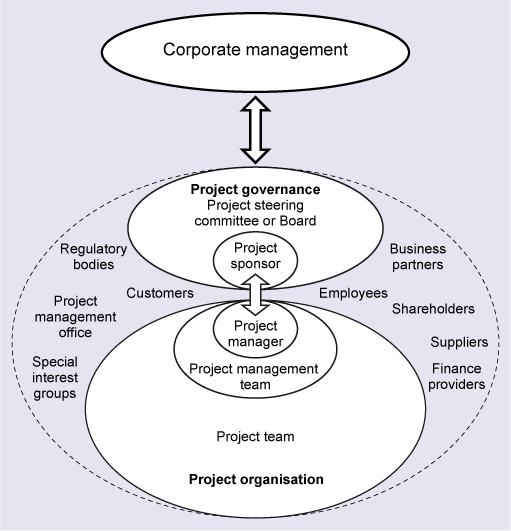1.1 The project board
The project board, also known as the project steering committee, is responsible for ensuring that the project is properly managed. The project board may be for that specific project, or a board may look after a group of projects in the organisation. Such a group of projects might be a programme or a group of individual projects. For a smaller project, the sponsor may undertake all the responsibilities for that project. For a larger project, the responsibilities may rest with a project board of which the project sponsor may be the chair. In an organisation without the infrastructure to support projects, the governance may be undertaken by the project manager who would then be directly responsible to the organisational management. However, in a large, project-oriented organisation, the project board sits between any projects and the organisational senior management.
Figure 2 is adapted from the International Standard ISO 21500 Guidance on Project Management (ISO, 2012). Senior management can be grouped together, but in Figure 2 the Corporate management stakeholders, who are part of the project and organisational infrastructure, are shown separately outside the system boundary of the project, although it may be appropriate to represent them inside the boundary, depending on structures within a particular organisation. The project sponsor is part of the project board or project steering committee. Following the definition of roles within ISO 21500:
- The project sponsor authorises the project, makes executive decisions, and solves problems and conflicts beyond the authority of the project manager.
- The project board contributes to the project by providing senior level guidance to the project.
PRINCE2 published by The Office of Government Commerce (OGC, 2009a) expresses the project board differently, including an executive, senior users and senior suppliers. The suppliers may be external to the organisation, or may be internal managers of the resources needed for the project. Senior users would usually be the customer, or representing views of the customer, whether this is an internal customer or an external customer. This is an example of governance applied across organisational boundaries and it can facilitate formal mapping of roles such as technical specialists communicating directly with each from different areas. The common aspect of the project board from both the ISO standard and PRINCE2 is that the project manager is responsible to the board, but is not part of the board. The project board may establish a ‘project assurance team’ that represents the three interests and performs this role working separately from the project team.
The project sponsor is the individual who has responsibility for ensuring that:
- appropriate governance mechanisms are in place for the project
- project assurance processes take place through periodic monitoring of the governance mechanism.
The monitoring may be by the project sponsor themselves, or by someone to whom the authority has been delegated. If delegated, this should be to someone who is external to the project.

